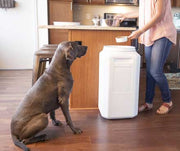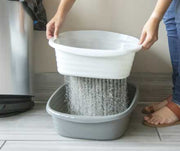How To Pick The Right Litter Pan For Your Cat

Welcoming a cat into your home can be quite an exciting time. Watching them explore their new home, sniff all the new smells, and find perfect little hiding spots around the house is one of the first things they'll do. After that, they'll probably look for their new food and water area, as well as find their place to use the restroom. Having your cat's litter box set up and ready to go before their arrival will help make the transition smoother and make your cat feel more comfortable in their new environment. Yet, going to the store to pick out your cat's litter box can be quite overwhelming. Who knew there was an entire aisle of litter pans with different designs, features, and styles?! Don't worry though! We're here to help explain the differences in litter pan designs and how you can pick the perfect one for your cat.
BEST LITTER BOX FOR KITTENS

The best litter box for kittens are open, basic litter pans. When bringing home a kitten, you'll have to teach him or her how to use a litter box. While teaching your new kitten to use the litter box, you'll have to place her inside the box and keep an eye on her to make sure she uses the restroom. Having a hood on the pan could make this task difficult, which is why open, basic litter pans are good for kittens. Another reason open litter pans are great for kittens is because of their low-profile design, which makes it easier for their small legs to climb up over to get into the litter box. At first, your kitten may need a little help from you to get inside the box, but over time she will learn and will be able to get in and out by herself. As your kitten grows, she will outgrow her basic litter pan and will need to transition into a larger litter pan. By this time, you'll know if your kitty is messy with their litter, needs more privacy, or just needs a bigger basic litter pan.
BEST LITTER BOX TO STOP LITTER SCATTER
Cats have a natural instinct to cover up their "mess" after using the restroom. If they're outside cats, they use their paws to wipe dirt or grass over it. If you're litter box trained, they use their paws to swipe litter over it. Depending on your cat's litter habits, this can get pretty messy and cause litter to scatter all over your floors if you've got an open, basic litter pan. Walking barefoot on your floors can feel like walking on tiny rocks and it is not fun to have to clean up every day. Lucky for you, Hooded Litter Pans were designed to help contain litter scatter! While a study done in April 2013 showed that cats really didn't have a preference in using hooded litter pans vs. open litter pans, hooded litter pans do provide a lot more convenience for cat parents. With a hood, cats are unable to kick litter over walls and onto the floor. Pet parents no longer have to look at used litter and they provide more privacy for your cat to do their business. Petmate's variety of hooded litter pans features large and wide designs for cats of all sizes. Plus, some even come with replaceable filters on the tops of the hood that absorbs odor, instead of letting it seep out of the pan. Some even have steps to get in and out, so that as your cat walks out of the pan, the steps catch litter that may have gotten stuck on your cat's paws. Hooded litter pans for cats really do add much-needed convenience when it comes to caring for your cat.

LITTER BOXES WITH HIGH WALLS
Litter boxes with high walls that surround 3 sides of the pan are called Rimmed Litter Pans. If you prefer your cat use a hooded litter pan, but your cat seems scared of the hood, a rimmed litter pan is a good option to slowly transition your cat from open pans to hooded pans. Like hooded litter pans, rimmed litter pans are also a good way to help prevent litter scatter. Their higher walls keep litter in and can look less intimidating to your cat as he hops in and out of the pan. Since there are only three sides with higher walls, some litter may scatter through the one side without the high wall. To contain that litter, you can place a litter mat that catches litter in front of the pan. That way as your cat jumps out of the pan, the leftover litter on his paws will get caught in the mat and not scatter on your floors.
BEST LITTER BOX TO KEEP DOGS OUT OF

Tired of your dog getting into the cat poop? While it may smell nasty to you, some dogs find that cat poop smells like cat food, which some dogs just can't resist. While your dog may be fine eating cat poop every once in a while, eating any poop can lead to your dog contracting bacteria or parasites in their body. You can stop this bad habit by getting your cat a Top Entry Litter Pan (shown below). Top entry litter pans are pans that have a tall, vertical, rectangular shape. They also have a lid on top that's secure enough to keep dogs out. The lid has a large enough hole that only cats can get in and out of. And since it has a taller design, the litter pan is deeper so that if your dog does happen to get his head into the hole, he won't be able to reach the litter at the bottom. Your cat will enjoy the privacy and you'll love that your dog is no longer munching on cat waste.

LITTER PAN MAINTENANCE
Your cat – or cats – will use their litter box multiple times per day. We recommend scooping/cleaning your cat's litter box at least once a day. Vets recommend that you have one more litter box than the number of cats you have. For example, if you have two cats, you should have three litter boxes. Location is also key when getting your cat to use their litter pan. You should place your cat's litter box in different areas of your house that are quiet and has less foot traffic. It's also recommended that you replace your cat's litter pan once a year. Over time, smells can seep into the plastic, which could make your cat not want to use their litter box. You can click here to learn more about litter pan maintenance.
Giving your cat a clean, quiet place to do their business will lead to a happy cat in your home. If you notice your cat acting weird, check their litter box. That may be their way of telling you it needs to be cleaned. Litter boxes come in all shapes and sizes. We hope this guide helped you understand what each style is designed for and how it can help add convenience to your life.
Sources:
Previous article

Next article

Related posts
View all-

What Can You Use Instead of Cat Litter?
Traditional cat litter is convenient, but it’s not the only option. Many cat owners look for alternatives to reduce waste, save money, or avoid chemicals found in clay-based kitty litter. Some options offer better odor control, while others are more eco-friendly or gentler on a cat’s paws.
Read Article -

How to Keep My Backyard Smelling Fresh
A clean backyard should smell fresh, unlike pet waste, smoke, or mold. Bad smells can linger, especially when dog poop, urine, or food scraps attract flies and bacteria. If your yard has a foul odor, it's time to take action. The first step is cleaning up pet feces, trash, or rotting food. A garden hose can wash away dirt and urine from artificial turf, patios, and decks. To neutralize odor, Use baking soda, white vinegar, and essential oils.
Read Article -

What Supplies Do First-Time Cat Owners Need?
Bringing home a new cat is exciting, but making them feel safe and comfortable takes more than love. First-time cat owners must prepare with the right supplies to ensure a smooth transition. From a litter box to cat food and a warm bed, having the basics ready can help your new kitty settle in faster. This guide covers everything a new cat owner needs to make their new pet feel at home.
Read Article



